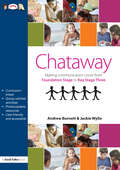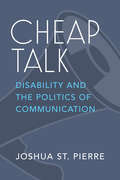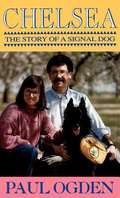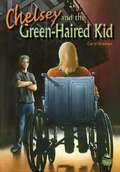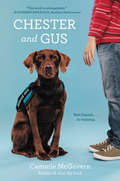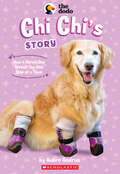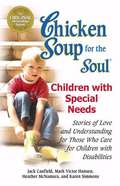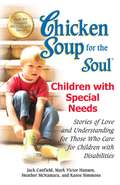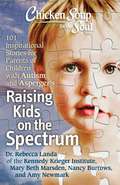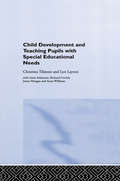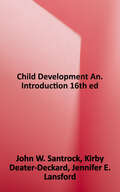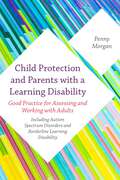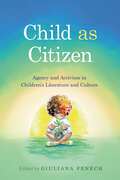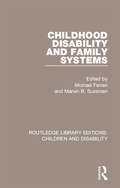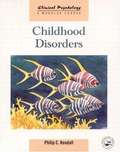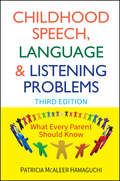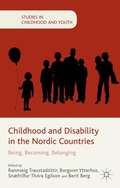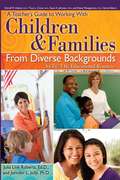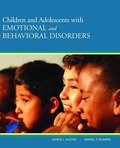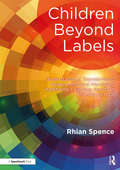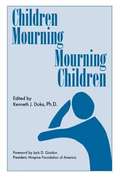- Table View
- List View
Chataway: Making Communication Count, from Foundation Stage to Key Stage Three
by Andrew Burnett Jackie WylieBased on the research of the Bristol Language Development Scales (BLADES), Chataway is a structured programme of work designed to help children develop speaking skills. Chataway is based around conversational skills, allowing children to prepare for social challenges as well as academic work the programme is written in a clear and straightforward way, with progress easy to monitor can be used with all children – those with average range skills and those with special needs group work focus extra training for staff not required. For all teachers and teaching assistants in settings from Foundation Stage and Key Stages 1 & 2, to pupils with special needs at Key Stage 3 and in Special Schools. The book is also relevant for parents, carers and all speech and language therapists and assistants working to develop speaking skills.
Cheap Talk: Disability and the Politics of Communication (Corporealities: Discourses Of Disability)
by Joshua St. PierreIn Cheap Talk: Disability and the Politics of Communication, Joshua St. Pierre flips the script on communication disability, positioning the unruly, disabled speaker at the center of analysis to challenge the belief that more communication is unquestionably good. Working with Gilles Deleuze’s suggestion that “[w]e don’t suffer these days from any lack of communication, but rather from all the forces making us say things when we’ve nothing much to say,” St. Pierre brings together the unlikely trio of the dysfluent speaker, the talking head, and the troll to show how speech is made cheap—and produced and repaired within human bodies—to meet the inhuman needs of capital. The book explores how technologies, like social media and the field of speech-language pathology, create smooth sites of contact that are exclusionary for disabled speakers and looks to the political possibilities of disabled voices to “de-face” the power of speech now entwined with capital.
Cheating Destiny, Living with Diabetes America's Biggest Epidemic
by James S. HirschDescribes living with diabetes in America's healthcare system
Chelsea: The Story of a Signal Dog
by Paul Ogden<P>Chelsea: The Story of a Signal Dog is the heartwarming, humorous, inspirational love story of a young deaf couple and the beautiful Belgian sheepdog who acts as their "ears" When Paul and Anne Ogden felt they needed a better link to the hearing world, they turned to Canine Companions for independence, a unique organization that trains dogs to help deaf and disabled persons live more successfully and creatively with their special needs. ... <P>Once the Ogdens return home with Chelsea, the story unfolds in lively detail. Life in a deaf family with an "almost human" dog seems to be a constant series of adventures and misadventures, and as Chelsea matures into a proud professional, readers will be utterly captivated by her charm. In addition to being a heartfelt animal story, the book shows us life in the deaf world ... <P>Poignant, touching, and joyful, Chelsea reveals deeper truths about the way we communicate or fail to communicate with one another, while conveying the spirit of triumph that once again proves that dogs are man's (and woman's) best friend. Chelsea is a love story guaranteed to delight. <P>Paul W. Ogden, professor of deaf education at California State University at Fresno, is the coauthor of The Silent Garden: Understanding the Hearing-Impaired Child. He lives with his wife, Anne Keegan Ogden, R.N., and their signal dog, Chelsea. When Paul is not teaching, writing, or beachcombing, he is collecting stories from deaf people for an anthology.
Chelsey and the Green-Haired Kid
by Carol GormanConvinced that the fatal accident she witnessed at the basketball game was not accidental, thirteen-year-old Chelsey, a paraplegic, and her unusual friend Jack join forces to prove it was a deliberate murder.
Chester and Gus
by Cammie McgovernCritically acclaimed author Cammie McGovern presents a heartwarming and humorous middle grade novel about the remarkable bond that forms between an aspiring service dog and an autistic boy in need of a friend. “Joyful, inspiring, and completely winning, Chester and Gus is unforgettable,” proclaimed Katherine Applegate, #1 New York Times bestselling author of the Newbery Medal winner The One and Only Ivan.Chester has always wanted to become a service dog. When he fails his certification test, though, it seems like that dream will never come true—until a family adopts him. They want him to be a companion for their ten-year-old son, Gus, who has autism. But Gus acts so differently than anyone Chester has ever met. He never wants to pet Chester, and sometimes he doesn’t even want Chester in the room. Chester’s not sure how to help Gus since this isn’t exactly the job he trained for—but he’s determined to figure it out. Because after all, Gus is now his person.In the spirit of beloved classics like Because of Winn-Dixie, Shiloh, and Old Yeller, Cammie McGovern’s heartfelt novel—told from Chester’s point of view—explores the extraordinary friendship between a child and a dog with a poignant and modern twist.
Chi Chi’s Story (The Dodo)
by Aubre AndrusThe true story of how a heroic dog spread joy one step at a time -- as seen on The Dodo!When the Howell family adopted Chi Chi, no one knew if this quadruple amputee golden retriever would ever run again. Chi Chi needed prosthetic limbs to help her walk on her own, and finding the right fit was sure to be a challenge. But this determined dog soon showed the world she could overcome any obstacle. And Chi Chi did it all while spreading hope, joy, and inspiration every step of the way!This story is perfect for middle-grade readers and includes eight pages of full-color photos!
Chicken Soup For The Soul: Stories Of Love And Understanding For Those Who Care For Children With Disabilities
by Mark Victor Hansen Jack L. Canfield Heather Mcnamara Karen Simmons'These powerful heart-rending stories are filled with honesty, humor, hope and offer inspiration to parents, teachers, and anyone else who cares for children with special needs. By embracing the magnificence, inner peace, and beauty each child possess, our own attitudes are shifted from despair to promise. ' Gerold G Jampolsky, M. D. , Founder of International Center of Attitudinal Healing, Sausalito , California. Raising a child with special needs is a lifelong commitment that is as unique as each person who embarks on it. Written by a variety of authors who share in this distinctive relationship, "Chicken Soup for the Soul: Children with Special Needs" offers a glimpse into the lives of others who are on a similar path. These stories provide insight, comfort, and connection with others who have walked this powerful and transformational journey. The authors of these candid stories relate their own experiences of adjusting, reaching out, and flourishing and share their universal worries, their tears, and the laughter that come with this extraordinary relationship. Most important, through these stories, you will be guided with the wisdom of fellow parents, caregivers, and those with special needs to help you be the very best parent or caregiver you can be.
Chicken Soup for the Soul Children with Special Needs
by Jack Canfield Mark Victor Hansen Heather Mcnamara Karen SimmonsRaising a child with special needs is a lifelong commitment that is as unique as each person who embarks on it. Written by a variety of authors who share in this distinctive relationship, Chicken Soup for the Soul Children with Special Needs offers a glimpse into the lives of others who are on a similar path. These stories provide insight, comfort, and connection with others who have walked this powerful and transformational journey. The authors of these candid stories relate their own experiences of adjusting, reaching out, and flourishing and share their universal worries, their tears, and the laughter that come with this extraordinary relationship. Most important, through these stories, you will be guided with the wisdom of fellow parents, caregivers, and those with special needs to help you be the very best parent or caregiver you can be.
Chicken Soup for the Soul Children with Special Needs: Stories of Love and Understanding for Those Who Care for Children with Disabilities
by Jack Canfield Mark Victor Hansen Heather Mcnamara Karen SimmonsRaising a child with special needs is a lifelong commitment that is as unique as each person who embarks on it. Written by a variety of authors who share in this distinctive relationship, Chicken Soup for the Soul Children with Special Needs offers a glimpse into the lives of others who are on a similar path. These stories provide insight, comfort, and connection with others who have walked this powerful and transformational journey. The authors of these candid stories relate their own experiences of adjusting, reaching out, and flourishing and share their universal worries, their tears, and the laughter that come with this extraordinary relationship. Most important, through these stories, you will be guided with the wisdom of fellow parents, caregivers, and those with special needs to help you be the very best parent or caregiver you can be.
Chicken Soup for the Soul: 101 Inspirational Stories for Parents of Children with Autism and Asperger's
by Amy Newmark Rebecca Landa Nancy Burrows Mary Beth MarsdenWith its 101 stories from other parents and experts, this book will comfort, encourage, and uplift parents of children with autism and Asperger's.If you are the parent of a child - from newborn to college age - with autism or Asperger's, you will find support, advice, and insight in these 101 stories from other parents and experts. Stories cover everything from the serious side and the challenges, to the lighter side and the positives, of having a special child on the autism spectrum.
Child Development and Teaching Pupils with Special Educational Needs
by Anna Williams Christina Tilstone Anne Anderson Richard Gerrish Lyn Layton Jenny MorganA thought-provoking book which provides a framework for understanding the physical, sensory, emotional, social, linguistic and cognitive development of children with special educational needs. It gives practitioners and students a sound grasp of the theoretical ground needed to fully understand cognitive development and will help them track children's developmental progress in order to optimise learning opportunities. The authors handle complex topics in a highly accessible manner, explaining how to put theory into practice. In three lucidly argued sections they present: an overview of the work of key theorists and thinkers, including Vygotsky, Piaget, Freud, Erikson, Bruner and the Korning theorists an evaluation of the educational implications of the work of each theorist, using illustrative case studies a consideration of areas of development in learning and teaching children with special educational needs. This book will be a beacon for teachers, head teachers, educational psychologists and all practitioners involved in special needs education who seek the opportunity to help empower their pupils, and enhance their own understanding.
Child Development, Sixteenth Edition
by John W. Santrock Kirby Deater-Deckard Jennifer E. LansfordThorough. Accurate. Reliable. Engaging. These are just a few words used by adopters and reviewers of Child Development. The topically organized 16th edition continues with Santrock's highly contemporary tone and focus, featuring over 1,000 new citations. The popular Connections theme shows students the different aspects of children's development to help them better understand the concepts. Used by hundreds of thousands of students over fourteen editions, the proven learning goals system provides a clear roadmap to course mastery. The new Guide to Diversity, Equity and Inclusion, found in the preface, highlights the many updates the authors have made in these critical areas.
Child Protection and Parents with a Learning Disability: Good Practice for Assessing and Working with Adults - including Autism Spectrum Disorders and Borderline Learning Disability
by Penny MorganChild Protection and Parents with a Learning Disability provides the practical knowledge that professionals need in order to understand common intellectual disabilities and how they might affect parenting capability. It presents clear guidance on how to carry out effective assessments and explains how interventions might differ when working with parents who have a learning disability. It covers a broad spectrum of disabilities, including borderline conditions and Autism Spectrum Disorder. The book also explores a number of emotional and mental health issues that can occur alongside learning disabilities, such as ADHD, anxiety, depression, and attachment disorders, to show how they should be understood in the context of cognitive abilities and the parenting role. Empowering practitioners to make informed decisions about children's welfare, this is a must-have guide for all professionals working with families where a parent is affected by a learning disability.
Child as Citizen: Agency and Activism in Children's Literature and Culture (Children's Literature Association Series)
by Giuliana FenechContributions by Daniela Brockdorff, Nina Christensen, Jill Coste, Katrin Dautel, Justyna Deszcz-Tryhubczak, Giuliana Fenech, Naomi Hamer, Irena Barbara Kalla, Anne Klomberg, Sonali Kulkarni, Elizabeth Leach-Leung, Ann Marie Murnaghan, Emily Murphy, Emilie Owens, Nicola Parker, Patrycja Poniatowska, Meg Rosoff, and Farriba SchulzChild as Citizen: Agency and Activism in Children’s Literature and Culture addresses children’s and young adult agency and activism across literature and culture, demonstrating how these forces influence child citizenship. Contributors to this volume highlight the agentic voices and activist practices that are growing across all spheres of young people’s lives, as well as the challenges to active citizenship that children growing up in unjust sociopolitical contexts face. The volume is interdisciplinary and draws on the sociology of childhood, children’s literature studies, youth culture studies, media, technology, and cultural studies, and Anthropocene, ecofeminist, and disability studies.Agency occurs in and around literature and storytelling, and this collection establishes how it is always influenced by identity as well as geopolitics; how it is both subjective and collective; how it is cultural and embodied; and how, like citizenship, it is not a static status but rather an ongoing negotiation. In this collection, contributors invite readers to consider agency as a system of relations between children themselves, between children and adults, children and institutions, and children and nation-states, as well as between children and the nonhuman. This book reviews the interconnectedness between these relationships and attempts to untangle some of the complications that emerge.
Child-guided Strategies: The Van Dijk Approach to Assessment
by Jan Van Dijk Andrea McDonnell Catherine Nelson Teresa OsterChild-guided Strategies: The Van Dijk Approach to Assessment : for Understanding Children and Youth with Sensory Impairments and Multiple Disabilities
Childhood Disability and Family Systems (Routledge Library Editions: Children and Disability #5)
by Michael Ferrari Marvin SussmanFirst published in 1987, this book focuses on childhood disability within the family. It examines the very nature of disability itself, as well as many of the fundamental elements of families. The book was written at a time when the meaning level of disability and its effect on family and society were rapidly changing and people with disabilities were starting to benefit from opportunities to compensate for whatever disabilities they may have had. Modern technology and an affluent society afforded advantages to support many of its disabled members. Contributors examine the contemporary context of disability, the cost of disability to families, ethical, philosophical and social issues underlying the treatment and rehabilitation of children with severe disabilities, and the role of professionals, amongst other topics. This book will be of interest to those involved in teaching, research and direct care with families who have children with disabilities. Although written in the late 80s, the work discusses subjects that are still vital today.
Childhood Disorders
by Philip KendallIn Childhood Disorders, Philip C. Kendall provides an up-to-date summary of the current information about the psychological disorders of childhood - their causes, nature and course - together with discussion and evaluation of the major models that guide psychological thinking about the disorders. Drawing on the research literature and case studies from his own clinical work, Kendall describes each of the major childhood disorders. He goes on to give a detailed consideration of the criteria used to make the diagnoses, a presentation of the latest research findings on the nature of the disorder, and an overview of the methods used and evaluations conducted for the treatment of the disorders. Throughout, the range of normal behavioural variations is set as the backdrop against which to make judgements about psychological disorders, and the role of the family in the onset and course of psychological difficulties is explored. Within the coverage of the treatments of childhood disorders, emphasis is placed upon those treatments that have been empirically evaluated and found to be effective in producing beneficial change for the children. In the end, a series of provocative questions are raised and the reader is asked to recognise and think about the personal and social implications of the decisions that we make regarding how we deal with the disorders of childhood. Childhood Disorders will provide an accessible, up-to-date introduction to the field for both students and professionals alike.
Childhood Speech, Language, and Listening Problems: What Every Parent Should Know
by Patricia McAleer HamaguchiThe essential, up-to-date guide for helping children with language and listening problems Does your child have trouble getting the right words out, following directions, or being understood? In this revised new edition of Childhood Speech, Language, and Listening Problems, speech-language pathologist Patricia Hamaguchi-who has been helping children overcome problems like these for more than thirty years-answers your questions to help you determine what's best for your child. This newest edition: * Expands on speech and articulation issues affecting toddlers * Includes a new chapter on socially "quirky" children Explains how to get the right help for your child, including when to wait before seeking help, how to find the right specialist, and how the problem may affect your child academically, socially, and at home Covers major revisions in educational laws and programs and insurance coverage as well as current information on new interventions and cutting-edge research in the field Updates information on autism spectrum disorders, neurobiological disorders, and auditory processing disorders "Provides valuable information for parents of children with speech, language, and listening problems."-Sandra C. Holley, Ph.D., Former President, American Speech-Language-Hearing Association (on the Second Edition) More than 1.1 million children receive special education services each year to address speech and language problems, and many others struggle with language and listening to some degree. If your child is one of them, this book gives you the crucial and up-to-date guidance you need to help him or her both in school and at home.
Childhood and Disability in the Nordic Countries
by Rannveig Traustadóttir Borgunn Ytterhus Snæfrídur Thóra Egilson Berit BergThis unique collection brings together seventeen leading Nordic scholars to offer a series of in-depth, research-based studies on disabled children and young people in Scandinavia. The first comprehensive scholarly text to focus on the many aspects of growing up with a disability, this volume presents the latest research from Denmark, Finland, Iceland, Norway and Sweden, all of which have an international reputation for progressive welfare and disability policies with regard to children andfamilies. It is based on the belief that in order to understand the lives of disabled children and young people it is important to combine social perspectives on disability studies with the social science of childhood and the human rights approach of the UN Conventions on the Rights of Persons with Disabilities and on the Rights of the Child. Many of the contributions focus on the experiences of the children themselves, with an emphasis on understanding the impact on their lives of social and environmental factors, cultural processes, and policy frameworks and definitions. Exploring a range of issues including theories and history of childhood disability, cultural images and identity formation, interaction and inclusion, and families and services, this collection will be essential reading for those interested in childhood and disability.
Childhood and Disability: Key papers from Disability & Society
by Sarah BeazleyDrawn from Disability & Society over the period 1997-2012, the twelve chapters in this book address a range of personal, cultural and institutional arenas in which challenges experienced by disabled children are played out. The book includes a mix of theoretical and applied material offering both powerful conceptual tools and practical insights, enabling readers to connect the work of recent decades to their own research and questions about disability and childhood. Readers will find this book an invaluable resource for understanding what we have learned about disability and childhood through the pages of the world leading international journal in the field. The collection makes available a well-informed understanding of conditions, policies and practices that create disability in children's lives so that we can further the struggle for a more inclusive future in which inequalities structured around impairment are removed. The importance of children’s own voices for resisting disablement in childhood is clearly foregrounded in this invaluable collection.This book was originally published as a special issue of Disability & Society.
Children & Families
by Jennifer L. Jolly Julia Link RobertsSchools are increasingly diverse in their student population, presenting new challenges for teachers. In light of these challenges, schools remain important in the talent development process. "A Teacher's Guide to Working With Children and Families From Diverse Backgrounds" provides important information and strategies for educators at all levels. The book is written for educators who want all children to thrive in school, including those who are twice-exceptional, those from lower income backgrounds, and others who have been underrepresented in gifted programming.
Children And Adolescents With Emotional And Behavioral Disorders
by Vance L. Austin Daniel T. SciarraThis first edition text is specifically designed to help teachers work successfully with children who exhibit emotional and behavioral disorders by affording readers a comprehensive and holistic repertoire of valuable, evidence-based treatment strategies. Written from the dual perspectives of an experienced clinician and a long-time educator, the school professionals and students who read it will better understand the role of both teacher and service provider, optimizing the coordination and effectiveness of the services that are critical to the success of these students.
Children Beyond Labels: Understanding Standardised Assessment and Managing Additional Learning Needs in Primary School
by Rhian SpenceChildren Beyond Labels is an accessible guide to understanding standardised assessment and managing high incidence additional learning needs in the primary school. It offers jargon-free insight into the results of formal assessments which are often used within professional reports and cuts to the core of how primary education professionals and parents can identify, understand and best meet children’s needs. Offering a range of practical and manageable strategies, the book provides clear explanations of commonly used labels which reflect three of the four areas described within the SEND Code of Practice (2015): Cognition and Learning; Communication and Interaction; and Social, Emotional and Mental Health. These categories are illustrated by 18 detailed case studies of children from the author’s own case work, each with their unique profiles of strengths, weaknesses and traits that can sometimes transcend category boundaries. Examples of these traits include: Dyslexia Autism Spectrum Disorder Specific Language Impairment Attention Deficit Hyperactivity Disorder Developmental Co-ordination Difficulties Anxiety. This is an invaluable guide to the range of different types of additional learning or special needs of children who are likely to be found in mainstream primary schools. It will be of interest to primary teachers, trainee teachers, teaching assistants, SENCOs, parents and anyone working to support the needs of young children.
Children Mourning, Mourning Children
by Kenneth J. DokaFrom the book: We [Hospice Foundation]aimed to produce something between a popular self-help book and an academic tome, a readable book directed primarily at caregivers, but which might also benefit a family dealing with a pediatric-related problem of grief and bereavement. We hope that Children Mourning, Mourning Children will find an audience beyond those who receive it at the teleconference.. We look forward to its continued use in training, counselling, and study." This book includes information to guide adults in answering both the questions of terminally ill children and those who know them. A useful resource for families, caregivers, and social service professionals.
